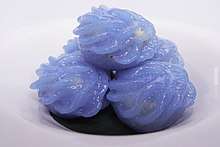Cho muang
Cho muang or chor muang (Thai: ช่อม่วง, pronounced [t͡ɕʰɔ̂ː mûa̯ŋ]), sometimes translated as Thai flower dumpling, is a traditional Thai savoury snack. Its existence has been documented since the reign of King Rama II (Phra Phutthaloetla Naphalai), in the Kap He Chom Khrueang Khao Wan poem. It is regarded as an ancient royal dish, and is marked by its carved flower-shaped appearance and indigo colouring from the anchan (Butterfly Pea) flower. It is a steamed dumpling which is made into flower-shaped forms that contain salty or sweet fillings, served with lettuce, coriander, and chili. The original recipe of cho muang contained a sweet filling and later was developed with the savory filling.[1] The name cho muang means 'violet bouquet'. It came from the appearance of a number of flowers in a plate arrangement.[2]
 | |
| Alternative names | Chor muang |
|---|---|
| Type | snack |
| Place of origin | Thailand |
| Region or state | Central Thailand |
| Serving temperature | warm |
| Main ingredients | garlic, pepper, coriander roots, vegetables, chicken, pork |
The exterior batter is made from rice flour, arrowroot flour, and tapioca flour stirred together in a brass pan. The violet color of the exterior batter comes from butterfly pea color mixed with a few drops of lime juice. Combined with seasoned meat filling, such as shrimp, fish, pork, or chicken fried with coriander root, garlic, and pepper until dry, and then molded into the shape of a flower with the batter by using tweezers to create the petal shapes of a flower before steaming. After the steaming process, it is sprayed with fresh coconut milk because of its original recipe as a sweet snack.
Because of the molding process into the flower shape requires delicate, time-consuming craftsmanship, and also the limited amount of time it can remain moist, Cho muang has become rare to find in a typical Thailand market. It now exists only in special dessert houses.[3]
Background
The history of cho muang has since ancient term. Which this snack was recorded during the King Rama II's period. Then, it has a unique appearance representing a rose, which it has method that was identity of cho muang. Also, people who try to making cho muang that be shape of a flower by pleat a dough. In the middle of this snack has seasoning such as garlic, pepper, coriander roots. Which these mixture are main seasoning of Thai food and Thai snack.[4]
Cho muang has a good scent like a flower, and this snack is purple like Poudean flower(Hibiscus mutabilis). So, it is like a woman that wear a purple shawl.
The poetry of King Rama II has content from Thai poem, which this poem is called Kap He Chom Khrueang Kho Wan. Also, this snack create by the Thai royal kitchen then is called chao wang's kitchen. This is explained about information both of Thai dessert and Thai food. The meaning of this verse is the cho muang has good taste and good smell as like flower. The color of cho muang is purple like colors of Poudean flower. Then, the cho muang is like a gorgeous woman that her put no with a purple shawl.[5][6]
Characteristic
Nowadays, cho muang is rarely found Thai snack. If cho muang is sold, it is expensive because this snack is a craft that requires many skills to make. Cho muang has a shape like a rose. Also, this Thai snack has purple color which it be similar purple rose. Then, the purple color come from the mixture between Blue pea and some lemon juice that is nature color.[7] [8] So, this knowledge was wisdom of Thai people in the past time. These people have creative to making this Thai snack. Then, the people are applied some method to changing color of cho muang. Which it is made beautiful and attractiveness whiles eating.
References
- "TrueYou ชวนชิม - ช่อม่วง". TrueYou (in Thai). Retrieved 30 April 2018.
- "ขนมช่อม่วง". Bloggang (in Thai). 12 February 2015. Retrieved 30 April 2018.
- "ช่อม่วง สวย อร่อย ครบรส". Post Today (in Thai). 26 June 2015. Retrieved 30 April 2018.
- "อร่อยทั่วไทย" (in Thai). 20 May 2013. Retrieved 5 May 2018.
- "ขนมไทยโบราณช่อม่วง" (in Thai). 23 Dec 2011.
- "ขนมช่อม่วง เมนูอาหารว่างแบบไทย ๆ" (in Thai). Retrieved 5 May 2018.
- "Food Story Team, สูตร-อาหาร, สูตรอาหารทานเล่น" (in Thai). 16 April 2015. Retrieved 5 May 2018.
- "Cho Muang (ช่อม่วง)". Bloggang (in Thai). 23 Dec 2011. Retrieved 5 May 2018.